NGC 1365 is a double-barred spiral galaxy located approximately 56 million light-years away in the southern constellation Fornax (the Furnace). The giant Seyfert-type galaxy is also known as the Great Barred Spiral Galaxy or the Fornax Propeller Galaxy. It is one of the brightest members of the Fornax Cluster.
The Great Barred Spiral Galaxy has an apparent magnitude of 10.3 and an apparent size of 11.2 by 6.2 arcminutes. The galaxy’s spiral arms extend into a Z-shaped halo that gives NGC 1365 a distinctive appearance. The arms stretch from the prominent central bar and curve north and south.
NGC 1365 is called the Great Barred Spiral Galaxy because it is one of the largest barred spiral galaxies in the sky and one of the best examples of its type. It has a diameter of 201,700 to 306,800 light-years.
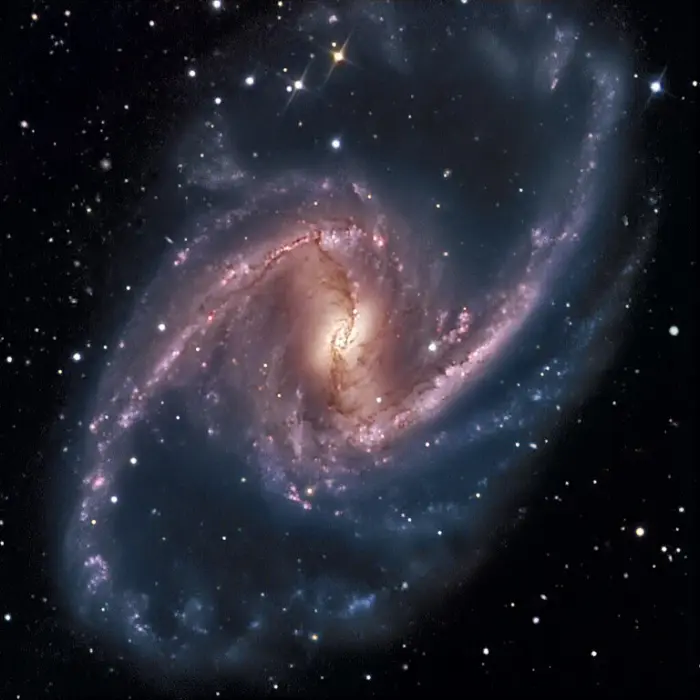
The Great Barred Spiral Galaxy (NGC 1365), image credit: SSRO/PROMPT and NOIRLab/NSF/AURA (CC BY 4.0)
However, NGC 1365 is not as large as the Condor Galaxy (NGC 6872), a barred spiral galaxy in the constellation Pavo. The Condor Galaxy has a diameter of more than 522,000 light-years and is the largest known spiral galaxy. It appears smaller than NGC 1365 in the sky because it lies at almost four times the distance, approximately 212 million light-years away.
The Great Barred Spiral Galaxy is known for its two central bars, the primary bar and the secondary nuclear bar embedded in the larger outer bar.
The larger long bar of NGC 1365 stretches across the galaxy’s centre and contains the smaller bar at the core.
The smaller bar has an apparent size of 50 by 40 arcseconds. It appears brighter in the infrared band because of instabilities of stellar orbits near the galactic centre, density waves, gravity, and rotation of the disk.
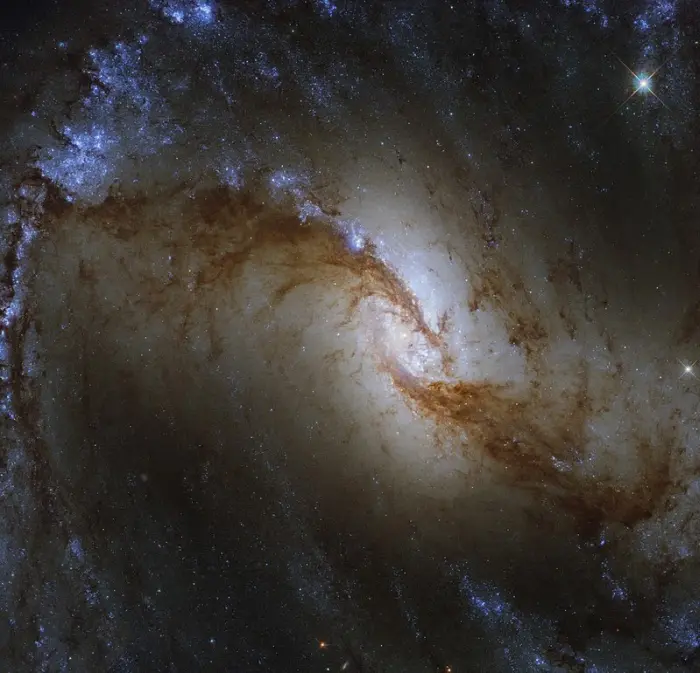
At around 60 million light-years from Earth, the Great Barred Spiral Galaxy, NGC 1365, is captured beautifully in this image by the NASA/ESA Hubble Space Telescope. Located in the constellation of Fornax (the Furnace), the blue and fiery orange swirls show us where stars have just formed and the dusty sites of future stellar nurseries.
At the outer edges of the image, enormous star-forming regions within NGC 1365 can be seen. The bright, light-blue regions indicate the presence of hundreds of baby stars that formed from coalescing gas and dust within the galaxy’s outer arms. This Hubble image was captured as part of a joint survey with the Atacama Large Millimeter/submillimeter Array (ALMA) in Chile. The survey will help scientists understand how the diversity of galaxy environments observed in the nearby universe, including NGC 1365 and other galaxies such as NGC 2835 and NGC 2775, influence the formation of stars and star clusters. Image credit: ESA/Hubble & NASA, J. Lee and the PHANGS-HST Team; Acknowledgment: Judy Schmidt (Geckzilla) (CC BY 2.0)
The inner bar is believed to rotate faster than the larger bar. The outer parts of the bar take about 350 million years to complete a rotation.
The larger bar is believed to play an important role in the evolution of the Great Barred Spiral Galaxy. It pulls gas and dust, creating regions of star formation and sending material to the galaxy’s central black hole. The star forming regions appear prominent at the ends of the central bar and along the galaxy’s spiral arms.
Other examples of double-barred spiral galaxies include Messier 96 (M96) in the constellation Leo, the Fireworks Galaxy (NGC 6946) in Cepheus and Cygnus, and NGC 7098 in Octans. Astronomers have suggested that our own galaxy, the Milky Way, may itself be double-barred.
In 2013, scientists were able to measure the rotation speed of the central black hole in NGC 1365 based on observations with the XMM-Newton spacecraft and the Nuclear Spectroscopic Telescope Array (NuSTAR) telescope. This was the first time anyone was able to accurately measure the spin of a supermassive black hole.
The researchers discovered that the supermassive black hole rotates at nearly 84 percent of the speed of light, which means that the surface is spinning at nearly light speed.
The black hole has a mass of around 2 million solar masses, which is half the mass of Sagittarius A*, the central black hole in the Milky Way galaxy.
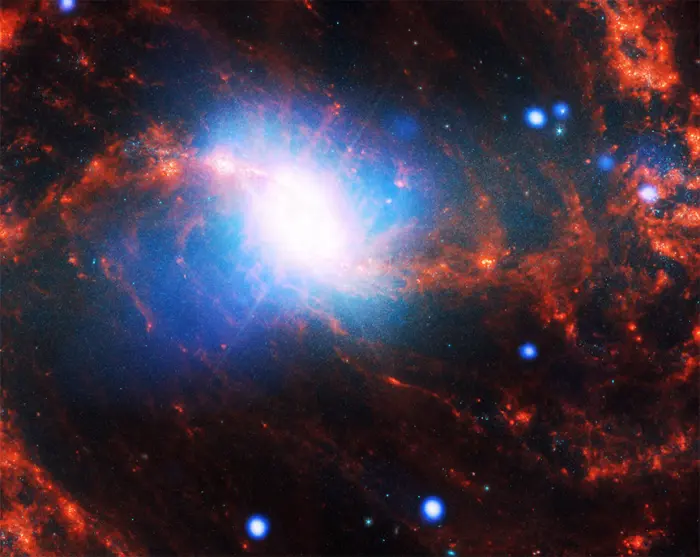
This spiral galaxy contains a supermassive black hole and stars rapidly forming in its center. Chandra sees X-rays from gas near the massive black hole and from smaller black holes or neutron stars pulling material from companion stars. X-rays from Chandra (blue); optical from VLT (yellow and blue); infrared from Webb (red, green, and blue), image credit – X-ray: NASA/CXC/SAO; Optical: ESO/VLT; Infrared: NASA/ESA/STScI/JWST/PHANGS; Image Processing: NASA/CXC/SAO/L. Frattare, J. Major (CC BY 2.0)
Facts
The Great Barred Spiral Galaxy was discovered by the Scottish astronomer James Dunlop on September 2, 1826. The English astronomer John Herschel observed it on November 28, 1837, and was previously credited for the discovery.
NGC 1365 is a member of the Fornax Cluster of galaxies. It has the designation FCC 121 in Ferguson’s Fornax Cluster Catalog. It is the fourth brightest galaxy in the cluster, after the lenticular radio galaxy Fornax A (NGC 1316), the lenticular galaxy NGC 1380, and the elliptical galaxy NGC 1399. The Fornax Cluster is the second richest galaxy cluster within 100 million light-years, after the much larger Virgo Cluster.
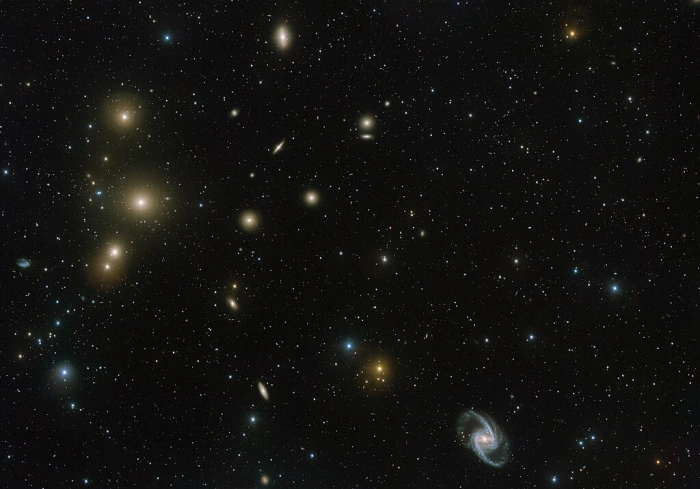
The Fornax Galaxy Cluster is one of the closest of such groupings beyond our Local Group of galaxies. This new VLT Survey Telescope image shows the central part of the cluster in great detail. At the lower-right is the elegant barred-spiral galaxy NGC 1365 and to the left the big elliptical NGC 1399. Credit: ESO; Acknowledgement: Aniello Grado and Luca Limatola (CC BY 4.0)
NGC 1365 looks similar to the barred spiral galaxies NGC 1300 in the constellation Eridanus (the River) and NGC 7479 in Pegasus. NGC 7479 is known as the Propeller Galaxy or the Superman Galaxy. It is listed as Caldwell 44 (C44) in the Caldwell catalogue of deep sky objects visible in amateur telescopes.
Four supernovae were observed in NGC 1365 in the last century. SN 1957C shone at magnitude 16.5 and was spotted by H. S. Gates in October 1957. SN 1983V, a type Ic supernova, was discovered by Australian amateur astronomer Robert Evans and independently by P. O. Lindblad and P. Grosbol in November 1983. It had an apparent magnitude of 13.5 at discovery.
SN 2001du was a type II supernova discovered by Robert Evans on August 24, 2001. It shone at magnitude 14. SN 2012fr was first spotted by the French astrophysicist Alain Klotz on October 27, 2012. It had an apparent magnitude of 14.7 and was classified as a type Ia supernova.
NGC 1365 was imaged by the James Webb Space Telescope (JWST) as part of the Physics at High Angular resolution in Nearby GalaxieS (PHANGS) program in January 2024. The observations of nearby galaxies with multiple ground-based and space telescopes – including the Hubble Space Telescope (HST), the Very Large Telescope (VLT), James Webb, and the Atacama Large Millimeter/submillimeter Array (ALMA) – aimed to provide astronomers with new insights into every stage of the star formation cycle and how gas and star formation are affected by galaxy-scale conditions.
Other galaxies observed in the study included the Phantom Galaxy (Messier 74) in the constellation Pisces, NGC 7496 in Grus, IC 5332 in Sculptor, and NGC 1433 in Horologium.
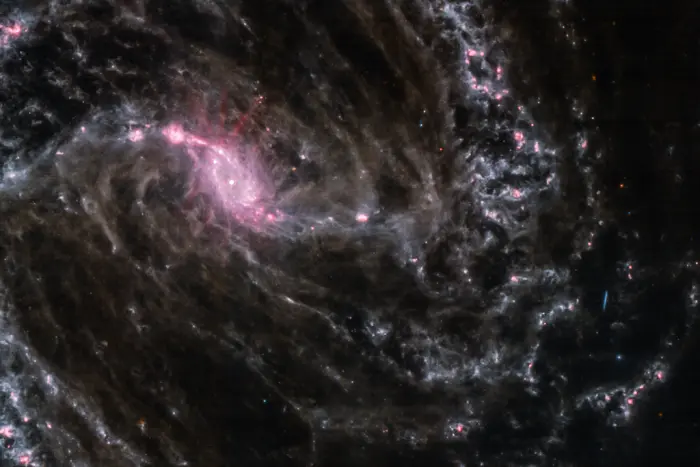
NGC 1365 captured by the MIRI instrument aboard the James Webb Space Telescope (JWST), image credit: NASA, ESA, CSA, and J. Lee (NOIRLab); processing: Judy Schmidt (CC BY 2.0)
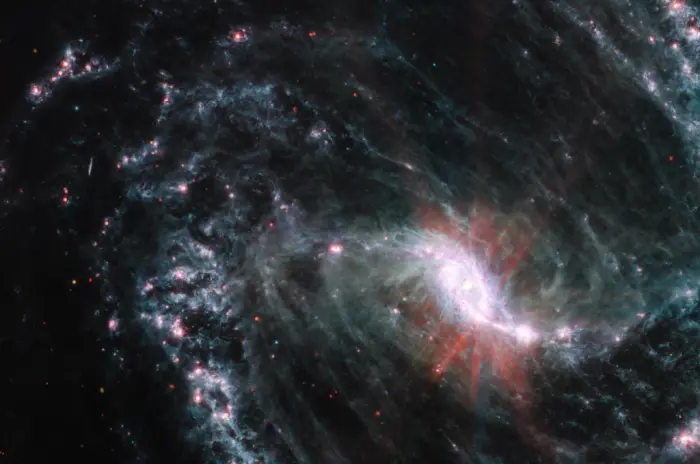
In the MIRI observations of NGC 1365, clumps of dust and gas in the interstellar medium have absorbed the light from forming stars and emitted it back out in the infrared, lighting up an intricate network of cavernous bubbles and filamentary shells influenced by young stars releasing energy into the galaxy’s spiral arms. In this image of NGC 1365, blue, green, and red were assigned to Webb’s MIRI data at 7.7, 10 and 11.3, and 21 microns (F770W, F1000W and F1130W, and F2100W, respectively). Credits: NASA, ESA, CSA, and J. Lee (NOIRLab). Image processing: A. Pagan (STScI) (CC BY 2.0)
Location
NGC 1365 lies in the area roughly halfway between Alpha Horologii and Dalim (Alpha Fornacis), near the stars f Eridani and g Eridani. The two Eridanus stars are found a little less than halfway from Achernar in Eridanus to Rigel in Orion.
At declination -36°, the Great Barred Spiral Galaxy never rises for observers north of the latitude 54° N and is best seen from the southern hemisphere. The best time of the year to observe the galaxy and other deep sky objects in Fornax is during the month of December, when the constellation appears higher above the horizon in the early evening.
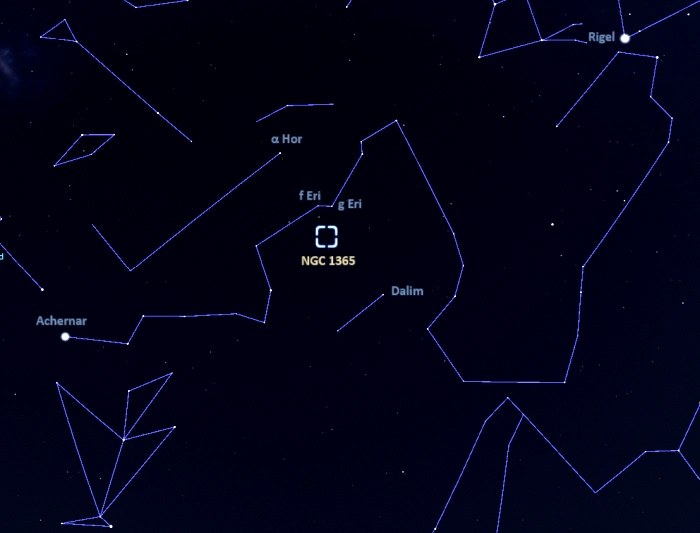
The location of NGC 1365 (the Great Barred Spiral Galaxy), image: Stellarium
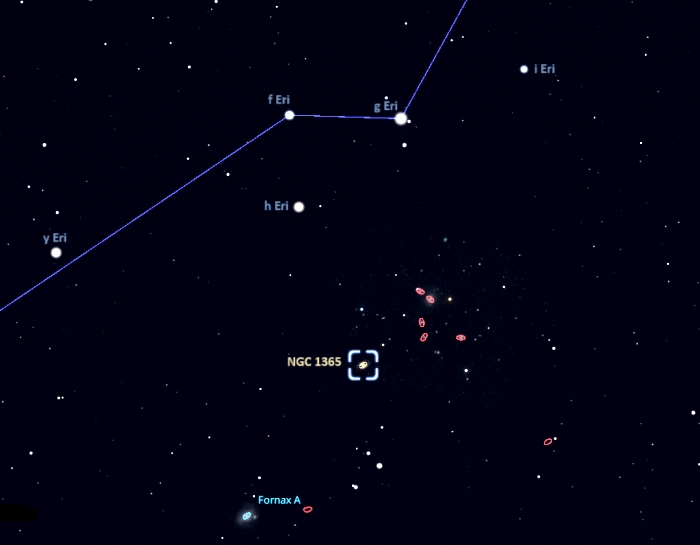
NGC 1365 finder chart, image: Stellarium
Great Barred Spiral Galaxy – NGC 1365
| Constellation | Fornax |
| Object type | Double-barred spiral galaxy |
| Galaxy type | (R’)SBb(s)b |
| Right ascension | 03h 33m 36.458s |
| Declination | −36° 08′ 26.37″ |
| Apparent magnitude | 10.3 |
| Apparent size | 11.2’ x 6.2 |
| Distance | 56 million light-years (17.17 megaparsecs); 74 Mly (22.69 Mpc) h−1 – light-travel |
| Redshift | 0.005457 ± 0.000003 |
| Heliocentric radial velocity | 1,636 ± 1 km/s |
| Size | 201,700 – 306,800 light-years |
| Names and designations | NGC 1365, Great Barred Spiral Galaxy, Fornax Propeller Galaxy, ESO 358-G 017, ESO-LV 358-0170, PGC 13179, UGC 5887, LEDA 13179, MCG -06-08-026, MRC 0331-363, VV 825, AGC 22699, 1E 0331.7-3618, 2E 794, 2E 0331.7-3618, FCC 121, FDS 17 0365, GLEAM J033336-360820, HIPASS J0333-36, SINGG HIPASS J0333-36, SWIFT J0333.6-3607, SWIFT J0333.5-3608, SWIFT J0333.7-3608, SWIFT J0333.7-3607, IRAS 03317-3618, 2MASX J03333645-3608263, PBC J0333.5-3608, JCMTSE J033336.1-360826, MAXI J0333-364, 2MAXI J0334-360, NVSS J033336-360826, NVSS J033336-360825, PKS 0331-363, PKS J0333-3608, PMN J0333-3608, QDOT B0331422-361823, SGC 033141-3618.4, SPASS J033336-360756, SRGA J033335.7-360832, SUMSS J033336-360826, WISE J033336.40-360824.5, 2XMM J033336.3-360825 |
Images
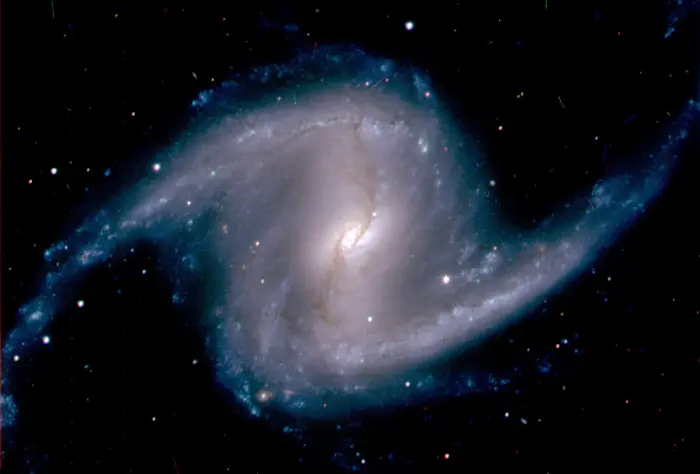
Zoomed-in image from the Dark Energy Camera of the barred spiral galaxy NGC 1365, in the Fornax cluster of galaxies, which lies about 60 million light years from Earth. Credit: Dark Energy Survey Collaboration, National Optical-Infrared Astronomy Research Laboratory (NOIRLab) (CC BY 4.0)
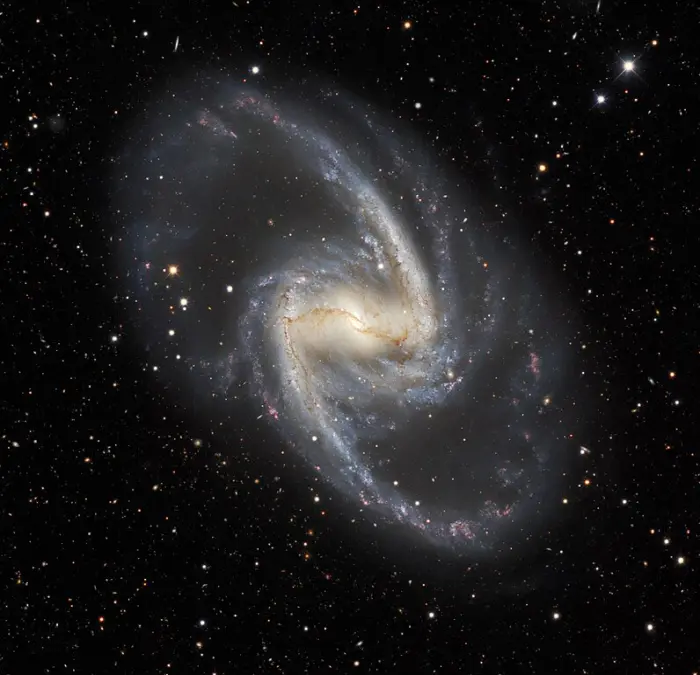
This image captures the elegant galaxy NGC 1365 in the Fornax Cluster of galaxies. Also known as The Great Barred Spiral Galaxy, NGC 1365 is a strikingly perfect example of a barred spiral galaxy. This image shows the galaxy’s prominent bar and its graceful spiral arms, with lanes of dust obscuring the extended diffuse glow of stars. The central bar of NGC 1365 influences star formation throughout the entire galaxy and conceals a supermassive black hole hidden behind multitudes of newly formed stars. Astronomers are interested in barred spiral galaxies like NGC 1365 for more than just their elegance — these galaxies provide insights into our home galaxy, the Milky Way, which is also a barred spiral galaxy. This image was built up using data from the Dark Energy Survey (DES), an ambitious project which mapped hundreds of millions of galaxies across the Universe using the Dark Energy Camera (DECam) on the Víctor M. Blanco 4-meter Telescope at Cerro Tololo Inter-American Observatory (CTIO). Credit: Dark Energy Survey/DOE/FNAL/DECam/CTIO/NOIRLab/NSF/AURA. Image processing: Travis Rector (University of Alaska Anchorage/NSF’s NOIRLab), Jen Miller (Gemini Observatory/NSF’s NOIRLab), Mahdi Zamani & Davide de Martin (NSF’s NOIRLab) (CC BY 4.0)
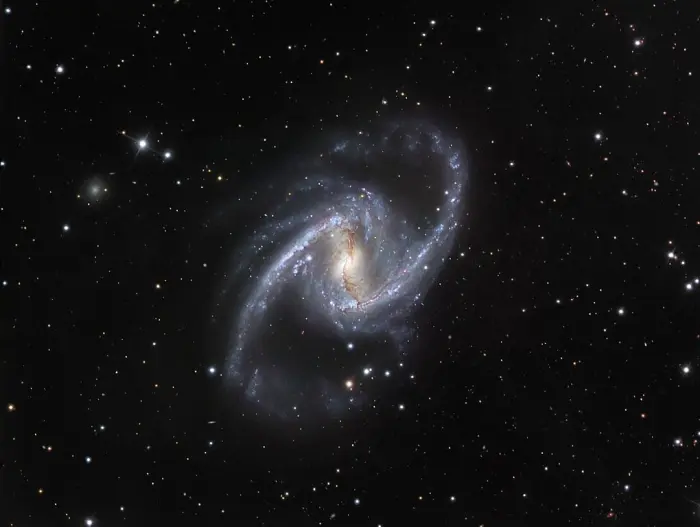
Spiralling around, 61 million light-years away in the constellation Fornax (the Furnace), NGC 1365 is enormous. At 200 000 light-years across, it is one of the largest galaxies known to astronomers. This, plus the sharply defined bar of old stars across its structure is why it is also known as the Great Barred Spiral Galaxy. Astronomers think that the Milky Way may look very similar to this galaxy, but at half the size. The bright centre of the galaxy is thought to be due to huge amounts of superhot gas ejected from the ring of material circling a central black hole. Young luminous hot stars, born out of the interstellar clouds, give the arms a prominent appearance and a blue colour. The bar and spiral pattern rotates, with one full turn taking about 350 million years. This image combines observations performed through three different filters (B, V, R) with the 1.5-metre Danish telescope at the ESO La Silla Observatory in Chile. ESO/IDA/Danish 1.5 m/ R. Gendler, J-E. Ovaldsen, C. Thöne, and C. Feron (CC BY 3.0)
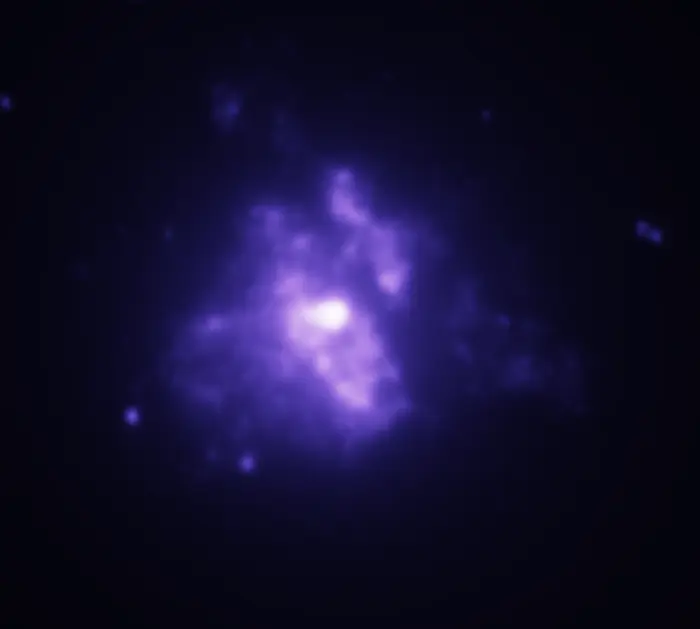
NGC 1365 by the Chandra X-ray Observatory, image credit: Chandra, processing: Judy Schmidt (CC BY 2.0)
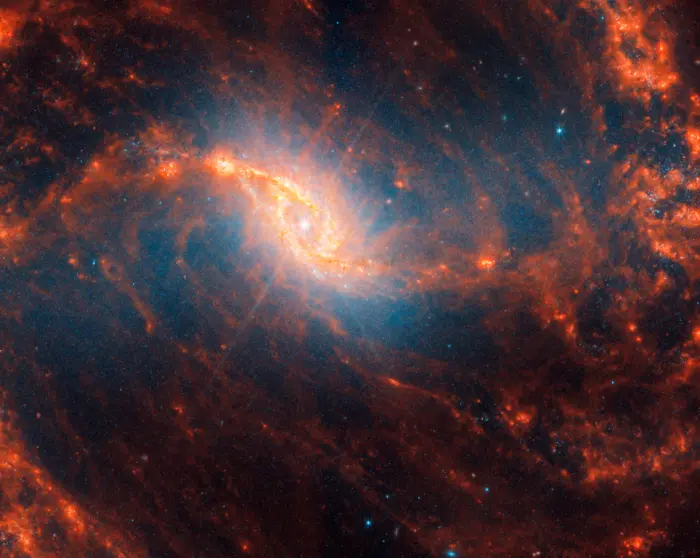
Barred spiral galaxy, NGC 1365, is split diagonally in this image: The James Webb Space Telescope’s observations appear on bottom right, and the Hubble Space Telescope’s at top left. Webb and Hubble’s images show a striking contrast, an inverse of darkness and light. Why? Webb’s observations combine near- and mid-infrared light and Hubble’s showcase visible and ultraviolet light. Dust absorbs ultraviolet and visible light, and then re-emits it in the infrared. In Webb’s images, we see dust glowing in infrared light. In Hubble’s images, dark regions are where starlight is absorbed by dust. Credit: NASA, ESA, CSA, STScI, Janice Lee (STScI), Thomas Williams (Oxford), PHANGS Team (CC0 1.0)